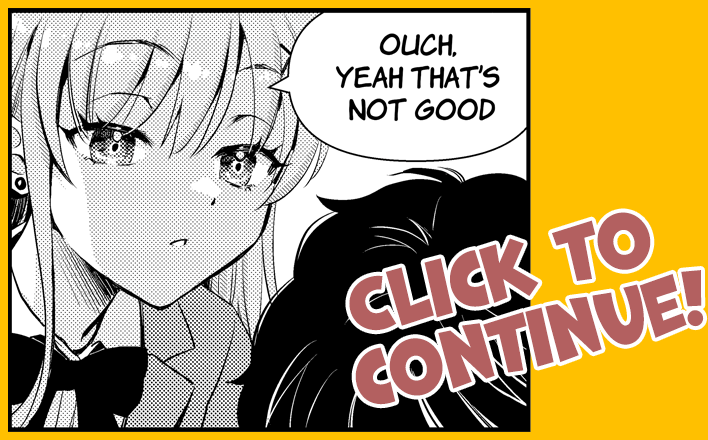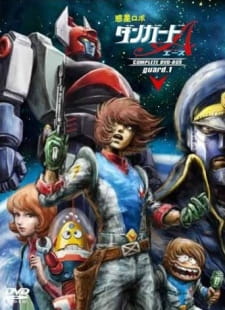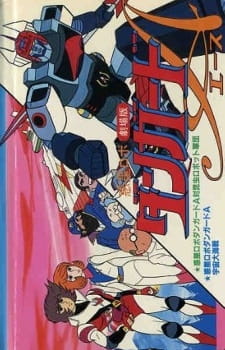Apr 27, 2024
Basic plot introduction: a universe of cyborgs and starships with Flat Earth style "planetoids" depends on a central figure, the Queen of the Great Planet to radiate Galaxy Energy and bless all with peace and prosperity. When denied this due to the current Queen falling victim to old age, all manner of normal things: animals, plants, fossils, inanimate objects - are mutated into monsters of rather original design. The Princess Aurora is sent to the Great Planet to bring an end to this, and three brave cyborg warriors go with her, Kugo Jogo and Hakka. Thus begins our epic adventure to save not only the
...
Earth, but the Galaxy.
Starzinger was renamed Spaceketeers for the United States' market, and this is the version that was overdubbed for the Yugoslav market and what I watched as a kid. Not much survived in my memory so I decided to watch the series. This review covers the original show (I have not seen Spaceketeers). It is one uneven show, with both strengths and weaknesses. But it certainly doesn't deserve to be wiped from existence, so I am perplexed by how it became as obscure as it is, considering it is a Leiji Matsumoto show.
Sure the weaknesses are easy to spot while the strengths only become apparent after a number of episodes, so if you know yourself to be impatient with anime and maybe value the smoothness of the animation over the work put into writing the characters and weaving the plot, this anime is probably not for you. The science is non-existent, scientific terms are thrown around and made to mean whatever, and generally any verisimilitude towards the natural world is missing. These are naive kids stories, imagine it as a story being told to a five-year-old. A definitive strength of the animation are the abstract landscapes of space, with vivid colours and strong strokes they give you impossible worlds. Otherwise the animation relies on repetition a lot, and styles of realism and caricatures will often clash. Characterisation can be very flat for most, only Kugo Aurora and select villains will be fleshed out, the rest will remain extremely simple.
However there are also strengths to Starzinger: the music and the drama. The funky tunes add a lot to a show built around action, however they too are used somewhat repetitively, to what you might or might not object. Finally, what I feel is the sole reason this anime might be worth watching is the character drama. Kugo is a hot-blooded warrior while Aurora is an idealist devoted to peace and universal well-being, and this conflict between our two main characters is what drives the plot for the first leg of it and remains to a lesser degree throughout. Always the difficult questions arise over what is the right thing to do, and these questions are underlined by personal experiences and grand tragedies. To build a kids show around moral dilemmas and tragic confrontations, how foreign! It is also worth noting that Starzinger bases itself on the Journey to the West, not unlike Dragon Ball or a number of other anime. And yes, on the topic of relationship dynamics, it is a reverse harem, with all three of our cyborg warriors pining for the Princess Aurora - I am told this is somewhat rare.
But I must tell you of Belamis. Rose of Versailles was a huge manga, and then it got its cult anime in 1979, after the conclusion of Starzinger. Belamis is a powerful rogue cyborg we encounter in episode 36. Kugo butts heads with them and they are rivals until episode 64. For episodes people are shocked to learn that this dangerous character driven by a passion for justice and a desire to prove ones mettle - is a woman. Big enemies to lovers and the obvious gender-nonconforming tag.
Also on the ending. In episode 64, our heroes have seemingly achieved what they had set out to do, but the abrupt news of new monsters is clumsily inserted at the end. Until episode 73 it is really Starzinger II, where things change a bit. Aurora and Kugo get upgrades, the Princess can now use Galaxy Energy and actually fight in battles, and Kugo gets some special circuitry that allows him a giant transformation, so at this point its an animated tokusatsu show. I found the actual ending satisfactory as the unspoken relations between the characters are finally stated and in a way resolved. For this final chapter of the story we get a clever bit of writing as the enemies scale in power as they exhibit more human traits - fighting alone cannot fix these problems, human interaction is necessary.
All in all, this is a show one watches for the character drama as the ideals of pacifism and the greater good are confronted with both a world that mutates everything into vicious monsters and the emotions that define our characters.
Reviewer’s Rating: 8
What did you think of this review?
Nice
 0
0
Love it
 0
0
Funny
 0
0
Confusing
 0
0
Well-written
 0
0
Creative
 0
0Show all





.png)
.png)






















